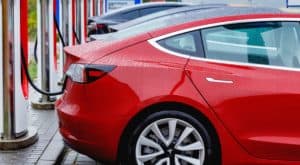
Thinking about trading in your gas guzzler in China for something battery powered and greener?
Those who hesitated to make the leap earlier have paid for it, with one manufacturer after another raising prices. Indecision could be even more costly going forward.
Automakers are demanding more money to cover the higher cost of raw materials. Tesla, BYD, Xpeng and Li Auto are just some that have raised prices in March.
Tesla’s Model Y Performance now costs 417,900 yuan ($65,600) after two price hikes in less than a week totaling 30,000 yuan. Some of Xpeng’s cars are as much as 20,000 yuan more expensive now. And a BYD model will set you back another 6,000 yuan, after a 7,000-yuan increase in January.
Among the biggest holdouts is Nio, which said last week it won’t be raising prices in the short term.
Let’s not forget China has been offering subsidies since 2009 as a carrot for those willing to become early adopters. It’s certainly worked. Last year, around 3 million new-energy vehicles, which includes plug-in hybrids, were sold. That’s expected to rise to 5.7 million units this year, according to BloombergNEF.
But here’s the rub: subsidies have already been cut by 30% this year and will be gone by the end of 2022.
If consumers are on-the-fence, they may want to rethink that indecision.
The combined effect of the most recent hike means Tesla’s standard-version Model Y in China now costs 316,900 yuan. That’s a 15% increase — or 40,900 yuan — from five months ago when it was previously eligible for the subsidy.
Tesla’s cheapest China-made car — and one that is still eligible for a subsidy — is the Model 3. That costs 279,900 yuan after discounts, still 44,000 yuan more than in November last year.
Once China stops all subsidies, that Model 3 will cost 290,888 yuan, assuming Tesla doesn’t change its current pre-subsidy price. That would be a 23% uplift in a little more than a year.
BNEF reckons more generally that EV prices remain expensive globally and need to fall around 25% to boost adoption. At least in China, plentiful makers, models and price points — including one of the country’s best-sellers, the entry level Wuling Hongguang Mini that costs less than 30,000 yuan — can still pull in new buyers.
Morgan Stanley however says EV makers will need to raise prices by 15%, citing the cost pressures on battery suppliers as Chinese prices for lithium carbonate spiral. The US investment bank warns of demand destruction, saying substantially higher prices may have a potential negative impact.
The net effect of price rises probably won’t show materially in EV monthly sales numbers. But the point is these cars are unlikely to cost less down the road, considering automakers’ willingness to raise prices on a whim and with subsidies fast fading. Car buyers may be delaying any EV purchase at their peril.
